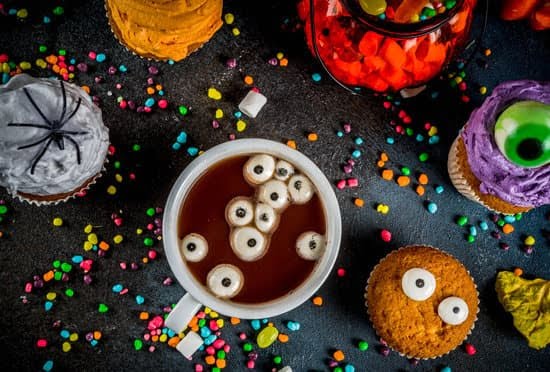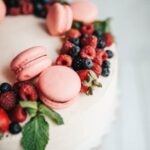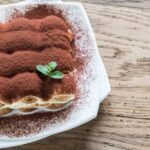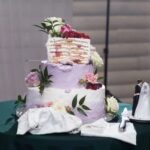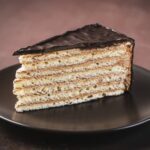Cake Decor Wrap is a versatile and essential tool in the world of cake decoration. Whether you are a professional baker or an enthusiastic home baker, cake decor wrap can elevate your cake designs to new heights. In this article, we will delve into what exactly cake decor wrap is and why it plays such a vital role in creating stunning cake decorations.
Cake decor wrap is a thin, flexible material that is specifically designed for use in cake decorating. It is available in various materials such as edible wafer paper, fondant or gum paste, and comes in an array of styles including patterns, colors, and textures. The primary purpose of cake decor wrap is to add visual interest and dimension to cakes, helping to create eye-catching designs that wow guests.
Using cake decor wrap allows decorators to easily achieve intricate patterns and designs that would be difficult or time-consuming to recreate by hand. Whether you want a delicate lace pattern or a bold geometric design, there is a cake decor wrap out there to suit your needs. By incorporating this versatile tool into your cake decorating arsenal, you have the ability to take your creations from ordinary to extraordinary.
In addition to its aesthetic benefits, cake decor wrap also serves practical purposes. It helps protect the surface of the cake from direct contact with hands and tools during the decorating process, ensuring a clean finish. Cake decor wrap can also act as a barrier between layers of frosting or fillings, preventing them from blending together and creating a mess.
Now that we understand what cake decor wrap is and why it matters in cake decoration, let’s dive further into its fascinating history and see how it has evolved over time. From its humble beginnings to the innovative uses and trends of today, the journey of cake decor wrap has been nothing short of intriguing.
A Brief History of Cake Decor Wrap
Cake decor wrap has been a staple in the world of cake decoration for many years. Its history can be traced back to ancient times when early civilizations would use various materials to enhance the appearance of their cakes. In this section, we will explore the origins of cake decor wrap and how it has evolved over time.
Origins of Cake Decor Wrap
The concept of using decorative wrappings for cakes dates back centuries. In ancient Greece, for example, cakes were often adorned with leaves and branches to symbolize fertility and abundance. Similarly, ancient Romans would use colorful ribbons and flowers to decorate their cakes for special occasions and celebrations.
As time went on, different cultures developed their own unique methods and materials for cake decor wrap. In Europe during the Renaissance period, icing made from sugar became popular, and elaborate designs could be created by applying this sweet mixture directly onto the surface of the cake.
The Evolution of Cake Decor Wrap
The modern form of cake decor wrap that we are familiar with today began to take shape in the 19th century. This was largely due to the development of new techniques and equipment that allowed bakers to create more intricate designs with ease.
In the late 1800s, tools such as decorating combs and piping bags were introduced, enabling bakers to achieve more precise patterns and textures on their cakes. At this time, edible decorations made from ingredients such as marzipan and fondant also gained popularity.
With advancements in technology throughout the 20th century, new materials like edible rice paper and wafer paper emerged as alternative options for cake decor wrap. These thin sheets could be printed with intricate designs or images that could be applied directly onto a cake’s surface.
Today, cake decor wrap continues to evolve alongside advancements in baking techniques and technology. From edible prints made with food-safe inkjet printers to textured molds that can create lifelike decorations, the possibilities for cake decor wrap are endless.
Overall, the history of cake decor wrap showcases the ingenuity and creativity of bakers throughout time. It has evolved from simple adornments to sophisticated designs, and continues to be a crucial element in creating visually stunning cakes.
Types of Cake Decor Wrap
Cake decor wrap comes in a variety of materials and styles, each offering unique properties and designs to enhance cake decoration. Understanding the different types available in the market can help bakers and cake decorators choose the right wrap for their specific needs. Whether it’s a classic, elegant look or a modern, vibrant design, there are options for every taste and style.
Fondant Wrap
Fondant is a popular choice for cake decor wrap due to its versatility and smooth finish. It can be rolled out into thin sheets or molded into intricate shapes to create textured designs. Fondant wrap is easy to work with and provides a polished look that highlights the intricacies of cake decorations. It also allows for various coloring techniques, such as marbling or creating ombré effects, making it ideal for both simple and elaborate designs.
Wafer Paper Wrap
Wafer paper is an edible material that offers a delicate and translucent appearance when used as cake decor wrap. It is perfect for creating ethereal or watercolor-inspired designs on cakes. Many bakers love wafer paper because it can be easily cut into shapes before adhering it to the cake with a small amount of water or edible glue. This type of wrap is often used for adding elegant floral patterns or intricate lace details to cakes.
Edible Image Wrap
Edible image wraps are made from thin layers of icing sheets that can be customized with any design or photograph using food-safe inkjet printers. These wraps provide a quick and convenient way to add detailed images or personalized messages onto cakes without the need for extensive piping or painting skills. Edible image wraps are especially popular for themed cakes like birthdays, anniversaries, or other special occasions where adding photos or logos would make the design extra special.
Patterned Roll Wrap
Patterned roll wraps are pre-printed with designs, patterns, or textures that can be easily transferred onto cakes. These wraps come in a wide variety of themes and styles, from delicate lace patterns to bold geometric prints. Patterned roll wrap offers a quick and easy way to achieve professional-looking cake designs without the need for additional artistic skills or time-consuming techniques.
Customizable Wrap
For those who want to add a personal touch to their cake decor wrap, customizable options are available. These allow bakers and decorators to design their own patterns or artwork using specialized software or templates provided by manufacturers. Customizable wraps offer endless possibilities for creating one-of-a-kind designs that perfectly match any theme or occasion.
By exploring the different types of cake decor wrap available in the market, bakers and cake decorators can find the perfect material and style to elevate their cake designs. Whether it’s the smooth finish of fondant wrap, delicate wafer paper, convenient edible image wraps, patterned roll wraps for quick patterns, or customizable options for a personalized touch – there is something for everyone to unleash their creativity on cakes.
Innovative Uses of Cake Decor Wrap
Cake decor wrap is a versatile tool that can be used in a variety of creative and innovative ways to enhance cake designs. Whether you’re a professional baker or a home baker looking to elevate your cake decorating skills, incorporating cake decor wrap into your designs can add a unique touch and make your creations stand out.
In this section, we will explore some of the most innovative uses of cake decor wrap and provide inspiration for incorporating it into your own cake designs.
Creating Texture and Patterns
One of the most popular uses of cake decor wrap is to create interesting textures and patterns on cakes. The flexible nature of the wrap allows for easy manipulation, making it perfect for adding intricate details to cakes. You can use it to create geometric patterns, floral motifs, or even mimic the look of lace.
Simply place the wrap on the surface of your fondant-covered cake and gently press it down to transfer the design. Remove the wrap carefully to reveal a beautiful pattern on your cake.
Edible Chocolate Wraps
Want to take your cake decorating game up a notch? Consider using edible chocolate wraps as an alternative to traditional fondant. These wraps are made from high-quality chocolate that is melted, spread onto a special transfer sheet, and then cooled until firm.
Once set, you can peel off the transfer sheet and apply the chocolate wrap directly onto your cake. Not only do these chocolate wraps add incredible flavor to your cakes, but they also allow for stunning artistic designs that are sure to impress.
Layering Cake Decor Wrap
Another creative way to use cake decor wrap is by layering different materials or patterns. For example, you can start with a base layer of fondant-covered cake and apply a lace-patterned decor wrap on top.
Then, using another piece of decor wrap with a different texture or pattern, apply it strategically over specific areas of the cake to create dimension and visual interest. This layering technique can result in a unique and eye-catching cake design that is sure to wow your guests.
By using cake decor wrap in these innovative ways, you can elevate your cake decorating skills and create visually stunning designs. Don’t be afraid to experiment with different materials, patterns, and layering techniques. The possibilities are endless with cake decor wrap, so let your creativity run wild and see how it can transform your cake designs.
Step-by-Step Guide
Cake decor wrap is a versatile and easy-to-use tool that can elevate any cake design. Whether you’re a beginner or an experienced baker, knowing how to properly apply cake decor wrap can make a significant difference in the final look of your cake. In this step-by-step guide, we will walk you through the process of using cake decor wrap for stunning results.
- Step 1: Prepare your cake – Start by baking and cooling your desired cake flavor. Once it’s completely cooled, level the top and sides of the cake to ensure a smooth surface for applying the decor wrap.
- Step 2: Choose your design – With various patterns and styles available in the market, select a cake decor wrap that suits your theme or desired look. It’s essential to consider the color scheme, texture, and overall aesthetics you want to achieve with your cake design.
- Step 3: Measure and cut – Carefully measure the height and circumference of your cake using a ruler or measuring tape. Add an extra inch to both measurements to account for overlap when wrapping the cake. Transfer these measurements onto the backside of the cake decor wrap with a pencil or marker, then use scissors or a utility knife to cut along these lines.
- Step 4: Apply edible adhesive – Apply an edible adhesive like piping gel, simple syrup, or food-safe glue sparingly on the backside of the pre-cut decor wrap. This will help adhere it securely onto your cake without damaging its taste or texture.
- Step 5: Wrap around the cake – Starting at one end, gently press one side of the decor wrap onto the prepared surface of your cake. Smooth it out from top to bottom with clean hands or with a fondant smoother tool if needed.
Slowly rotate your turntable or cake stand as you continue to press the decor wrap onto the sides of the cake until you reach the starting point. Trim off any excess decor wrap if necessary. - Step 6: Finishing touches – Once the decor wrap is securely in place, lightly run your fingers or a smoother tool over any visible seams or edges to blend them seamlessly into the cake. You can also add additional elements like ribbons, sugar flowers, or edible paints to further enhance the overall design.
Following these step-by-step instructions will ensure a successful application of cake decor wrap for stunning and professional-looking results. Experiment with different patterns, textures, and materials to create unique designs that showcase your creativity in cake decoration.
DIY Cake Decor Wrap
Cake decor wrap is a versatile tool that can add a unique and personalized touch to your cake designs. While there are many options available in the market, creating your own custom cake decor wraps at home allows you to truly make your cakes one-of-a-kind. In this section, we will provide you with some tips and tricks on how to create DIY cake decor wraps.
Tips for Creating DIY Cake Decor Wraps
- Choose the right material: When creating your own cake decor wraps, it’s important to choose a material that is safe for food contact and won’t affect the taste or texture of the cake. Some popular choices include edible wafer paper, fondant sheets, or even rice paper. Experiment with different materials to see which one works best for your desired design.
- Use edible ink or food coloring: To add color or patterns to your DIY cake decor wraps, consider using edible ink markers or edible food coloring mixed with a little vodka (which evaporates quickly). This will allow you to draw or paint directly onto the wrap, creating intricate designs or beautiful watercolor effects.
- Get creative with stencils: Stencils are an easy way to add intricate shapes and patterns to your cake decor wrap. You can either purchase pre-made stencils or create your own by cutting out shapes from acetate sheets or even parchment paper. Simply place the stencil on top of the wrap and use an airbrush gun, food coloring spray, or even powdered sugar to add beautiful designs.
| Tips for Creating DIY Cake Decor Wraps | |
|---|---|
| 1. Choose the right material: | When creating your own cake decor wraps, it’s important to choose a material that is safe for food contact and won’t affect the taste or texture of the cake. Some popular choices include edible wafer paper, fondant sheets, or even rice paper. Experiment with different materials to see which one works best for your desired design. |
| 2. Use edible ink or food coloring: | To add color or patterns to your DIY cake decor wraps, consider using edible ink markers or edible food coloring mixed with a little vodka (which evaporates quickly). This will allow you to draw or paint directly onto the wrap, creating intricate designs or beautiful watercolor effects. |
| 3. Get creative with stencils: | Stencils are an easy way to add intricate shapes and patterns to your cake decor wrap. You can either purchase pre-made stencils or create your own by cutting out shapes from acetate sheets or even parchment paper. Simply place the stencil on top of the wrap and use an airbrush gun, food coloring spray, or even powdered sugar to add beautiful designs. |
These are just a few tips to get you started on creating your own DIY cake decor wraps. The possibilities are endless when it comes to customizing your cakes with unique designs and personal touches. So grab some materials and let your creativity shine.
Pro Tips for Using Cake Decor Wrap
Using cake decor wrap can elevate your cake decoration game to the next level, but it’s important to know some pro tips to ensure a smooth application and professional-looking results. Here are some expert recommendations to help you troubleshoot common issues and achieve stunning cake decorations:
- Prepare your cake surface: Before applying the cake decor wrap, make sure your cake is properly prepared. Smoothly frost the surface of the cake, ensuring there are no bumps or imperfections that could affect the application of the decor wrap. It’s also essential to chill the cake in the refrigerator before applying the wrap, as it will help adhere the wrap better.
- Handle with care: When handling the cake decor wrap, be mindful not to apply excessive pressure or stretch it too much. This could cause tearing or distortions in the design. Gently peel off the backing paper from one corner and slowly place it onto your chilled frosted cake. Use a smoothing tool or your hands to gently press down and remove any air bubbles.
- Trim excess wrap: Once you have applied the decor wrap onto your cake, carefully trim any excess edges using a sharp knife or scissors. Make sure to maintain a clean and precise cut for a professional finish.
- Experiment with layering: In addition to using a single piece of decor wrap, try layering different designs or colors for unique effects. You can create depth and dimension by overlapping different wraps, allowing you to create more intricate and eye-catching designs on your cakes.
- Practice makes perfect: Don’t be discouraged if your first attempt doesn’t turn out exactly as planned. Like any new skill, using cake decor wraps requires practice and experimentation. Take time to familiarize yourself with different techniques and designs, and don’t be afraid to try new things.
By following these pro tips and practicing your cake decor wrap techniques, you’ll soon be able to achieve professional-looking cake decorations that will impress your friends, family, and clients. Let your creativity shine and have fun exploring the endless possibilities of cake decor wrap.
Cake Decor Wrap Trends
Keeping up with the latest trends in cake decoration is essential for creating modern and visually appealing designs. Cake decor wrap is no exception, as it offers a versatile and easy way to add texture, color, and pattern to cakes. In this section, we will explore the current trends in cake decor wrap to help you stay updated and inspired.
- Metallic Accents: One of the hottest trends in cake decor wrap right now is metallic accents. From shimmering gold and silver foils to rose gold patterns, metallic finishes add a touch of elegance and sophistication to any cake design. Consider using metallic cake decor wraps for special occasions such as weddings or anniversaries for a luxurious look.
- Geometric Patterns: Geometric shapes and patterns continue to be popular not only in interior design but also in cake decoration. With cake decor wraps featuring bold lines, squares, triangles, and hexagons, you can create visually striking designs that are both modern and timeless.
- Floral Prints: Flowers are always a classic choice for cake decoration, but now they can be easily incorporated with cake decor wraps featuring delicate floral prints. From dainty roses to vibrant tropical blooms, floral patterns offer endless possibilities for creating romantic and whimsical cake designs.
- Watercolor Effects: Embrace the artistic trend of watercolor by using cake decor wraps that mimic the ethereal qualities of this painting technique. Soft pastel hues blended together seamlessly on the wrap can create an enchanting backdrop for your cakes.
- Marble Designs: Marble patterns have become increasingly popular in home décor, fashion, and now even in cake decoration. Cake decor wraps featuring marbled effects offer a chic and sophisticated look that is perfect for contemporary designs or minimalist aesthetics.
By staying updated with these latest trends in cake decor wrap, you can ensure that your cake designs are fresh and stylish. Experiment with different patterns, materials, and techniques to create unique and eye-catching cakes that will impress your clients or guests. Remember to always have fun and let your creativity take the lead when using cake decor wrap in your designs.
Inspiring Cake Decor Wrap Ideas
Cake decorating is an art form that allows bakers to create visually stunning and delicious treats. One way to enhance the beauty of a cake design is by incorporating cake decor wrap. This section will showcase some inspiring cake designs that incorporate cake decor wrap, providing readers with visual inspiration for their own creations.
One popular technique when using cake decor wrap is creating a lace-like effect on the cake. This can be achieved by using a delicate lace patterned wrap and applying it to the surface of the cake. The result is a stunning and elegant design that adds a touch of sophistication to any occasion. Some bakers have also experimented with combining different patterns and colors of wrap to create unique and eye-catching designs.
Another visually captivating idea is using metallic or glittery cake decor wrap. This adds a touch of glamor and sparkle to the cake, making it perfect for special events or celebrations. Whether it’s a gold or silver wrap, or even one with holographic effects, these wraps can instantly elevate the overall look of the cake and make it stand out.
For those who prefer a more whimsical and fun approach, there are cake decor wraps available in playful patterns such as polka dots, stripes, or floral prints. These can be used to create themed cakes for birthdays, baby showers, or other festive occasions. By incorporating these wraps into the design, bakers can add an element of delight and cheerfulness to their creations.
| Cake Design | Description |
|---|---|
 | A classic lace-inspired design created by applying a delicate lace patterned wrap onto the surface of the cake. |
 | A glamorous cake design featuring a metallic or glittery wrap that adds sparkle and shine to the overall look of the cake. |
 | A whimsical cake design with a playful wrap featuring polka dots, stripes, or floral prints for a festive and fun look. |
Cake Decor Wrap FAQs
As the popularity of cake decor wrap continues to grow, it’s natural for newcomers to have questions and concerns about this creative tool. In this section, we will address some frequently asked questions to help you gain a better understanding of cake decor wrap and ensure successful results in your cake decorating endeavors.
- One common question is: “What is cake decor wrap made of?” Cake decor wrap is typically made from various edible materials, such as wafer paper, sugar sheets, or fondant. These materials are food-safe and designed specifically for use in cake decorating. They come in different colors, patterns, and textures, allowing decorators to add intricate designs and unique elements to their cakes.
- Another frequently asked question is: “How long does it take for the wrap to set on the cake?” The drying time for cake decor wrap depends on the material used and the surrounding conditions. Wafer paper generally dries quickly within a few minutes once applied to a moist surface.
Sugar sheets can take longer to set, usually requiring at least an hour before they become firm. Fondant-based wraps may take several hours or overnight to fully dry. It’s important to consider the humidity level in your environment as higher humidity can prolong drying times. - A concern that often arises is: “Can I use cake decor wrap on any type of cake?” Cake decor wrap can be used on most types of cakes, including buttercream-covered cakes, fondant-covered cakes, and even naked cakes.
However, it’s crucial to ensure that the surface of your cake is clean and free from excess grease or moisture before applying the wrap. Additionally, it’s recommended to avoid using heavy toppings or fillings that may cause the delicate decorations of the wrap to become soggy or lose their shape.
By addressing these FAQs and concerns about cake decor wrap, you now have a better understanding to confidently use this versatile tool in your cake decorating projects. Keep in mind that experimentation, practice, and personal creativity are key to achieving stunning results with cake decor wrap. So don’t hesitate to explore different techniques and designs to create your own unique cake masterpieces.
Conclusion
In conclusion, cake decor wrap is an essential tool for enhancing cake designs and adding a touch of elegance to any creation. Throughout this article, we have explored the history, types, uses, and techniques of cake decor wrap to provide a comprehensive guide to all cake enthusiasts.
From its origins as a simple paper wrapper to the wide variety of materials and styles available today, cake decor wrap has come a long way in terms of innovation and creativity. Whether you are looking for a classic lace pattern or a bold metallic design, there is a cake decor wrap out there that will suit your style and vision.
We have also seen how cake decorators are using this versatile product in innovative ways, pushing the boundaries of traditional cake designs. From creating textured layers to incorporating unique shapes and prints, the possibilities with cake decor wrap are endless.
So why not give it a try? With our step-by-step guide on how to use cake decor wrap and tips for creating your own custom wraps at home, you can easily achieve professional-looking results. Don’t be afraid to experiment with different patterns and trends – let your imagination run wild.
Embrace the world of cake decor wrap and elevate your cake designs to new heights. Your creations will not only look stunning but will also leave a lasting impression on anyone who sees them. So go ahead, get creative, and let your cakes make a statement with the beauty and versatility of cake decor wrap.
Frequently Asked Questions
How do you wrap a decorated cake?
Wrapping a decorated cake requires care and attention to ensure that the cake remains intact and the decoration stays in place. Start by chilling the cake in the refrigerator for at least an hour, as this will make it easier to handle and less prone to crumbling. Next, choose a suitable wrapping material such as plastic wrap or aluminum foil. Place the cake on a sturdy cardboard base or a cake board before wrapping it.
Carefully drape the chosen material over the cake, making sure to cover it entirely without any gaps. Smooth out any wrinkles or air bubbles to maintain a neat appearance. Use additional materials like ribbons or cling film to secure the wrap tightly around the cake and prevent it from sliding off during transportation or storage.
What is a cake wrap?
A cake wrap refers to a covering used to protect and preserve a decorated cake during transportation or while stored for future use. It acts as a protective layer that shields the cake from external factors like air exposure, which can cause it to dry out or become damaged.
A good quality wrap also helps retain moisture within the cake, ensuring its freshness is maintained for longer periods. The design of a cake wrap can vary depending on personal preference or occasion, ranging from simple plastic wraps to more elaborate decorative materials like fondant icing sheets.
What do you use to wrap a cake?
There are various options available when it comes to choosing what material to use for wrapping a cake. Plastic wrap is commonly used due to its flexibility and ability to tightly cling onto surfaces, helping keep moisture inside while protecting against dust and debris. Aluminum foil is another popular choice as it provides excellent protection against air exposure and is more durable than plastic wrap.
Parchment paper can also be suitable for loosely covering cakes that require breathable protection without direct contact with plastic wrap or foil’s surface. It’s important to ensure that whatever material is selected is clean, food-safe, and securely fastened around the wrapped cake to maintain its integrity throughout transport or storage durations.

Welcome to our cake decorating blog! My name is Destiny Flores, and I am the proud owner of a cake decorating business named Cake Karma. Our mission is to provide delicious, beautiful cakes for all occasions. We specialize in creating custom cakes that are tailored specifically to each customer’s individual needs and tastes.

